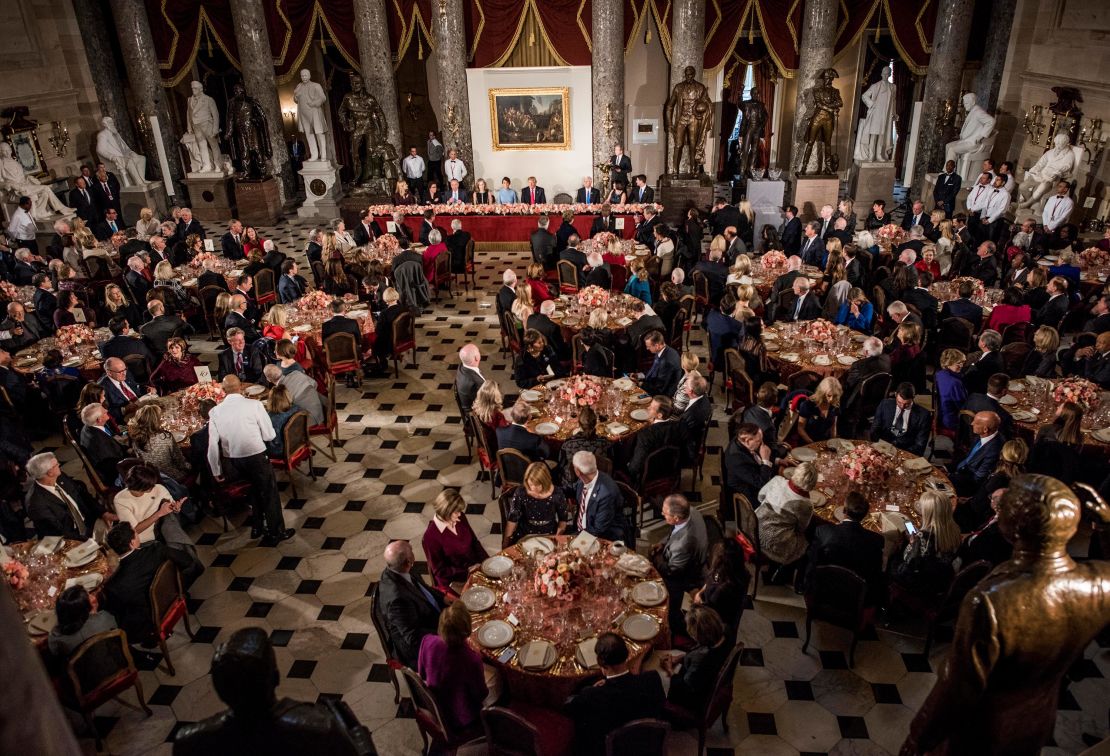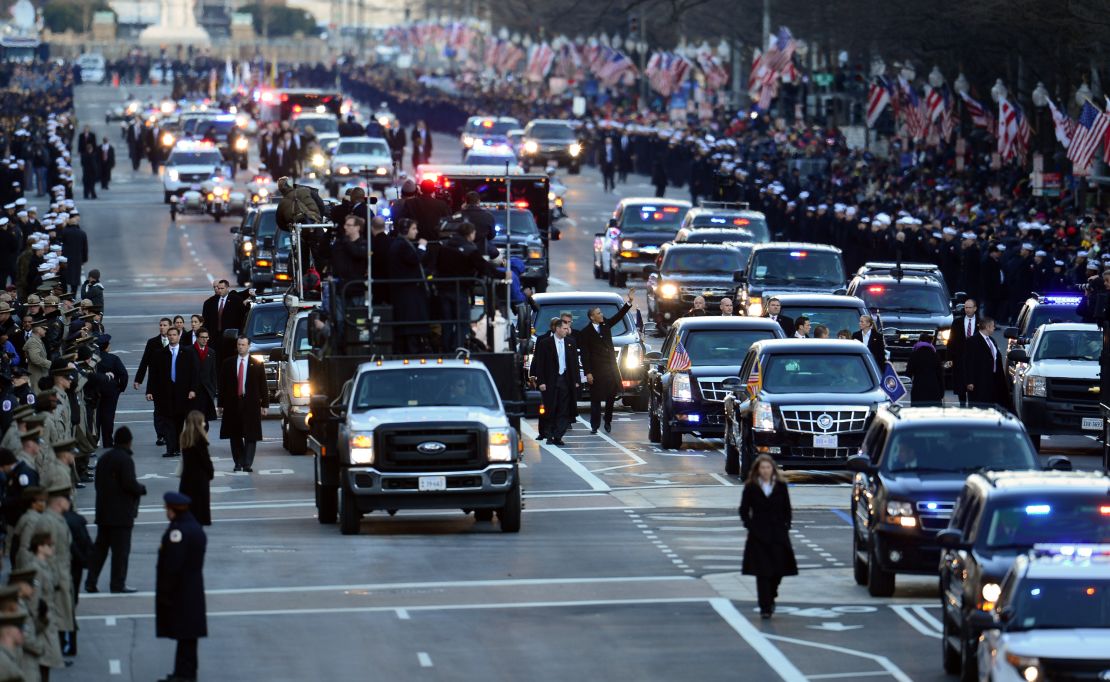Outside President Donald Trump’s bedroom window on the north side of the White House is the sound of building: hammers, drills, the beep-beep of trucks backing up and metal planks clanking into place.
Construction of the parade platform for President-elect Joe Biden’s inauguration festivities is well underway. The viewing stand and bleachers are almost complete and each day they get closer to being done – all within Trump’s view – as it becomes clearer his days in the White House are coming to a close.
Despite the uncertainty of the coronavirus and Trump’s waning attempts to overturn the election, the structure is a growing reminder of the transition now in motion. Whatever else must change to accommodate the pandemic, people are getting ready for Biden’s inauguration come January, which will likely reflect the President-elect’s cautious, science-driven approach to the pandemic.
What’s more, the outgoing president may not even go to the incoming president’s swearing-in. Three White House officials familiar with Trump’s moods and patterns speculate he won’t be there for the hand-off.
“I can’t foresee a scenario where he goes and that tradition carries on as normal,” one of the officials tells CNN.
Trump White House
No doubt, the pomp and circumstance will be noticeably different this time around, according to interviews with multiple aides and administration officials, from the White House to Capitol Hill to the DC mayor’s office. The future of the traditional luncheon in Statuary Hall is up in the air, and it’s unlikely a choir behind the new President will be feasible.
The expectation is the inauguration will be smaller, too, and attendees will have to wear masks and maintain social distance within the ticketed parameters.
The congressional committee tasked with choreographing the festivities at the Capitol has tried to map out plans for a range of scenarios with consultation from medical experts, aides say.
The committee has been in an awkward limbo since Election Day, as Trump’s refusal to accept his loss mounted. While unable to dive-in exclusively with Biden’s team, the committee has spent the last several months making plans for whoever won the election. Aides maintained neutrality in recent weeks as Trump’s denial dragged on, communicating with both his and Biden’s teams as to what the options could be for January 20.
A scaled back event
The congressional committee is tasked with everything that happens within the ticketed parameter of Inauguration Day, which typically includes the vicinity from the Capitol itself to Fourth Street on all sides, an area that usually holds roughly 200,000 people. The iconic VIP platform – the setting of that image of politicians from both parties looking on as the new President takes the oath of office, surrounded by his spouse and family – holds 1,600 people.
No final decisions have been made as of yet, per the source, but it’s expected the platform will host far fewer than 1,600 people. There is also ongoing discussion about requiring Covid testing for anyone who remains on the main platform near Biden.
One aide cautioned the maximum number of tests that are currently able to be processed on Capitol Hill is approximately 300 per day, which could fall short of the normal volume of people allowed on the platform.
Biden said over the summer that he did not want to wear a mask for his Inauguration ceremony and an aide tells CNN that this is still the President-elect’s preference.
As with most things on Capitol Hill, the day’s historic events have their own currency. Members of Congress often use their allotted Inauguration tickets to ingratiate themselves with powerful constituents or high-rolling donors, the cache of being part of history is a sizable carrot to dangle.
Frustration is mounting this week, however. Those familiar with planning say members have not yet been told how many tickets they will have to distribute, if any. Instead, they’re being told to jot down names of those interested in attending and let those people know they’re in a holding pattern.
One thing the congressional committee has determined, no matter the number of attendees: everyone in the ticketed area will be required to follow mask and social distancing guidelines.
And the choir that is usually positioned on risers behind the President may not happen at all, according to an aide. The Marine Band, which has played at every inauguration since 1801 is still scheduled to participate.

One tradition that could also face rollbacks is the Inaugural Luncheon, held after the swearing-in. It is the first meal the new President eats, and it is usually served with 200 or so members of congressional leadership in attendance in Statuary Hall, the large tiled room with high-ceilings and dramatic columns.
The ceremonial lunch dates back to 1897, for President William McKinley, and new presidents pick their menus with care. President Obama’s swearing-in menu in 2009 was inspired by Abraham Lincoln, and featured seafood stew and American birds including pheasant and duck.
But the hall is typically packed tight for the luncheon, a dangerous thing in a pandemic especially as health experts have warned about the risks of indoor dining. This year, event planners will have to weigh carefully what kind of message a lunch could send to the American public who has been told over and over again to stay home and avoid exposing themselves and others to the virus.
Aides warn perception is everything. A recent memory, the fallout from the controversy earlier this month when House Democrats hosted an in-person new member dinner in the room. They allowed only two members per table and distanced the space between diners, but the public blowback led to an eventual cancel of the dinner. Instead, members got boxed dinners to take home.
Questions about a parade
The swearing in ceremony and the luncheon are just two of the areas of the inaugural day festivities that could look different this year. There are still questions about what a parade will look like with the D.C. Mayor’s office moving ahead with plans for one, but still uncertain about how it ultimately will unfold.
“We are planning for a parade as well as the other elements of the inauguration traditions; however, each inauguration reflects the person being sworn in so we await the appointment of the Presidential Inaugural Committee to understand how we can support their vision,” Susana Castillo, the mayor’s spokesperson said. On Wednesday this week, DC will revert to modified Phase Two Covid protocols, after spikes in numbers. For outdoor gatherings, the number of allowed people drops from 50 to 25.

The bulk of what the committees, the city and the National Park Service may have to do will be crowd control – to a degree and in a way that perhaps no other celebratory parade has had to do before. Throngs will want to celebrate Biden’s swearing-in; at Barack Obama’s inauguration in 2009, there were 1.8 million people, according to city officials.
This is something the Biden team is contemplating, still, shy of eight weeks to go.
“The trick is to allow for celebration, but not in person,” says a source with knowledge of the planning discussions. “It feels almost an impossibility, but it is the only option.”
The source adds team Biden is all too aware of the power of presidential persuasion and anything short of virtual audiences will certainly compromise the authenticity of what the President-elect has been touting about being virus-aware. The success of the virtual Democratic National Convention in August is currently the model of how to successfully pull off a seamless Inaugural, says the source, who indicates there will likely be a large streaming component to the events of January 20, including the evening’s balls and entertainment, again much in the same vein as the DNC.
Celebrations without the physical camaraderie of those participating will also impact Washington itself, a city that gets a huge financial boon whenever a new President comes into office.
Hotels are booked months in advance, deposits are made on event venues for the dozens of Inaugural Balls, and smaller pre- and post-parties are hosted by DC’s society mavens and ambassadorial hierarchies, to welcome in a new administration.
“Those of us in the industry are bracing ourselves for a very quiet January,” says a longtime high-end event planner in Washington. “No one is counting on the business we would typically expect during an inaugural year.”
CNN’s Arlette Saenz and Pete Muntean contributed to this report.


